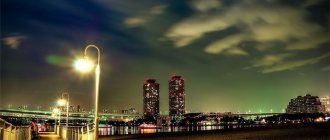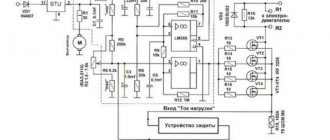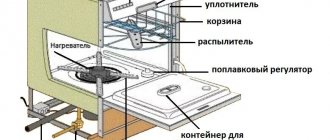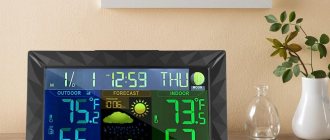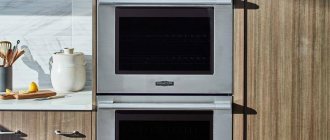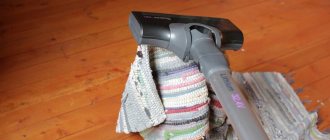Assembling the device
Any SLR camera is unassembled in its original packaging. To be precise, the body, lens and battery are located separately. First of all, you should remove the protective cap from the lens and the camera itself. After this, the lens is put on the device. To do this, you need to find a white dot on the lens and align it with the white dot on the body. After this, the lens is rotated clockwise until it clicks.
The second stage is installing the battery. This is also quite easy to do. The battery compartment is located at the bottom of the camera and opens with a special latch. You need to pull it down, and the compartment lid will open. The battery is placed in the camera with the side with the contacts. In general, it is impossible to mix it up here, since it simply won’t fit on the other side.
The memory card slot is most often hidden under the battery compartment cover, but on some models it may be located on the right side. The memory card is inserted with the contacts facing forward.
Most often, the camera in the box will be discharged, or the battery will have a small percentage of charge. Before you start using it, it is best to fully charge it so that it does not run out during the first setup. Charging in most cases is carried out not by connecting the entire device to the network, but using a separate battery charger. The battery should be removed and inserted into the charger. During the process, the red lamp will light up, which will turn green after charging is complete. In rare models, the charging function via a USB cable is available. Modern batteries do not require charging and draining them completely. They do not have a memory effect, as was the case in older types of batteries, so the battery is not afraid of partial charging and discharging.
Advice! To charge your Canon camera, you should use original chargers. This is the only way to extend the life of the battery and not ruin it ahead of time.
First start
Once the battery is charged and the lens is attached, it's time to turn on the camera. Before you start using it, you will need initial setup, during which you set the date, time zone, language and other system parameters. In fact, the initial setup of a Canon camera does not require special knowledge or additional instructions. The device displays information on the display, and the user simply needs to act according to the suggested actions.
After the first turn on is completed, the camera will in most cases ask you to format the memory card. If the card is new, then such a need will definitely appear. You can do this in three ways:
- using a laptop or computer;
- upon direct request for a camera;
- through settings.
There is no point in considering the first option in detail, since it is not the best. The fact is that any technology formats the media for itself, and sometimes it happens that a memory card formatted in a laptop is not readable by the camera. For this reason, it is best to do this using the technique in which the card will be used.
In the case when the card is new and the camera does not understand how to work with it, it will simply write on the display that you need to format the media and offer to do it right now. In this case, the user just needs to agree.
If the card has been used before or just needs to be cleaned, formatting can be done using a special option in the settings. To do this, on the device itself, press the “Menu” button, then select the item with the drawn key. In this menu item, you can change all system settings, for example, reset the date, including formatting the memory card.
Advice! The device will offer two types of formatting: quick and normal. The first option is suitable for new cards, the second for previously used ones or those that produced errors.
Camera Settings - Picture Style
By default, the settings of your Canon DSLR camera should be set to the “standard” mode, which is suitable for beginners in almost all situations, but you can experiment, for example, set the “landscape” mode, this mode enhances blue and green colors. Portrait mode softens the subject's image settings and produces softer colors.
Most photographers set their own mode settings by editing existing modes. For example, the “Landscape” mode on our camera has now been slightly changed; we have increased the sharpness, contrast and color scheme. If you have a high-quality lens, then you don’t have to mess with these settings, especially since you can always edit the image in Photoshop.
That's all the basic settings of a Canon camera that we wanted to tell you about and give you tips for the first time to improve the quality of your photography. We recommend experimenting more and after some time, you will know which basic camera settings for shooting will suit you best. Take photographs and travel with travel-picture.ru.
Camera modes
Any camera, regardless of class, has different shooting modes. Some of them are automatic, and the second half will require you to configure one or another parameter for specific shooting conditions.
All modes of a Canon camera can be seen on the mode scroll wheel - it is located at the top. The selection of modes is carried out by rotating it. A short white line marks which mode is selected; accordingly, to select another, you need to scroll the wheel to the desired option. The number of modes may vary depending on the model. At the same time, they can decrease or increase only due to automatic shooting programs. Semi-automatic modes are unchanged - there are always four of them.
Automatic modes include macro photography (flower on a wheel), sports mode (running person), portrait mode (person's face), automatic (green empty rectangle) and others. In these modes, the user only needs to point the camera at the subject and, after focusing, which is also done automatically, press the shutter button.
Semi-automatic modes are designated by the letters M, Av, Tv, P. When working with them, the photographer will need some knowledge and understanding of working with aperture and shutter speed. However, the pictures here will turn out to be more interesting.
P mode
P or program mode does not differ globally from automatic mode, but allows the user to adjust the aperture within limited limits. It is also possible to adjust the white balance.
Most experienced photographers find Program mode to be completely useless. The manufacturer notes that it will help novice users switch from automation to manual settings.
Av mode
Av – aperture priority. In this case, the user sets the aperture size himself in order to experiment with the amount of light transmitted and the final image. Based on the aperture size, the camera itself selects the shutter speed and takes the photo. Using this mode you can influence the depth of field.
Advice! When using, it is not recommended to set the maximum and minimum aperture values, as the likelihood of artifacts appearing in the photo increases significantly.
Using this mode, you can adjust the sharpness and blur the background. To make the objects in the photo clearer, you need to set a lower aperture value; if you want to blur the background and focus on the main objects, then select a high value for the shutter speed.
It is worth understanding that the aperture setting depends on the lens that is connected to the camera. That is why, when changing optics, you need to choose not only a lens, but also set new shooting parameters for it. Another nuance - on different cameras the same lens may require new settings.
TV mode
TV – shutter priority. In this mode, the user selects the time for which the aperture will transmit light; accordingly, the aperture size itself is selected automatically. Using this feature is indispensable when shooting sports events or moving objects. Also, different exposure times can give interesting effects, for example, a photo with wiring. The mode will appeal to those who like to photograph any movement, regardless of whether it is a person, an animal or a natural phenomenon.
M mode
M – manual mode. With its help, the user has access to simultaneous adjustment of aperture and shutter speed. Suitable for those who know exactly what they are doing and what they want to achieve. The mode is especially good at night, when the camera, due to the darkness, does not understand what aperture and shutter speed it should set. The user can choose the parameters he needs. This is the mode most often used by professionals. Beginner users simply will not understand how this or that parameter affects the photo.
Basic exposure modes
Since the 1980s, four modes have been standard on most cameras: program mode ( P ), aperture priority mode ( A or Av ), shutter priority mode ( S or Tv ), and manual mode ( M ). It's the 21st century, but camera manufacturers haven't come up with anything fundamentally new. Using the classic four, you can still shoot anything. Other modes (with rare exceptions) are from the evil one.
Program mode
P – Program auto. Program automatic or program line mode is not only the most preferred mode for the novice amateur photographer, but also a completely acceptable choice for an experienced photographer, especially in situations where you have to shoot in a hurry.
In program mode, the camera independently sets the appropriate combination of aperture and shutter speed in accordance with lighting conditions and ISO sensitivity (see Light and Exposure Numbers). By default, the following range of combinations is used: f/2*1/15; f/2.8*1/30; f/4*1/60; f/5.6*1/125; f/8*1/250; f/11*1/500; f/16*1/1000; f/22*1/2000, etc. within the aperture range of a particular lens and the shutter speed range of a particular camera. Of course, intermediate values of the form are also possible: f/6.3*1/160; f/7.1*1/200; f/9*1/320; f/10*1/400, etc., since the values of both shutter speed and aperture usually change in increments of a third of a stop.
To reduce or increase the exposure relative to that offered by the machine, use the exposure compensation or exposure compensation function. For example, in contrasting lighting on many cameras, you have to reduce the exposure by 1/3 or 2/3 of a stop to avoid overexposure in the highlights, and when shooting winter scenes, the exposure should be increased so that the snow does not appear gray in the photo. Typically, exposure compensation is controlled by a dedicated (+/-) button in conjunction with the main command dial. It’s even more convenient when a separate disk is provided for exposure compensation.
A feature of good cameras is the ability to perform program shift, i.e. choose equivalent combinations of aperture and shutter speed to obtain the same exposure in accordance with the law of reciprocity.
Let me give you an example. A typical exposure on a sunny day is achieved with an exposure pair of f/8*1/250 at ISO 100. Based on the principle of reciprocity, the same exposure can be achieved using any of the following combinations: f/2*1/4000; f/2.8*1/2000; f/4*1/1000; f/5.6*1/500; f/11*1/125; f/16*1/60; f/22*1/30. By turning the appropriate dial, you can shift the program either toward larger apertures and slower shutter speeds, or toward faster shutter speeds and smaller apertures. Such a program is called flexible.
ISO sensitivity in program mode is set either manually or automatically, depending on your preferences and camera capabilities.
Aperture priority
A – Aperture priority or Av – Aperture value. Aperture priority mode is deservedly loved by many photographers. In this mode, you independently set the aperture value you need within the range limited by the lens design, and the camera automatically selects the appropriate shutter speed for it. Exposure compensation in this case also affects only the shutter speed, as the only variable in the exposure pair.
Most of my work is shot in aperture priority mode. Manual aperture control means full control over the depth of field of the imaged space, which is extremely convenient both when shooting landscapes, when the depth of field should be maximum, and when shooting portraits, when you want to visually separate the subject from the background using a shallow depth of field. In addition, the overall sharpness of the image depends on the aperture, and therefore it is highly advisable to keep such an important parameter under supervision.
Shutter priority
S – Shutter priority or Tv – Time value. Shutter priority mode is the opposite of aperture priority. In this case, you manually set the shutter speed, and the camera selects the aperture. Shutter priority is useful when you need to limit the minimum shutter speed to prevent blur when shooting fast-moving subjects.
In general, this mode is less convenient and versatile than aperture priority, since, firstly, variations in shutter speed do not have such a noticeable effect on the image as changing the aperture, and secondly, due to the fact that the range of aperture numbers is noticeably narrower than the range shutter speeds, the camera, being in shutter priority mode, often hits the limiting aperture values, which results in underexposure or overexposure of the frame. By the way, you can now usually limit the minimum shutter speed through the automatic ISO sensitivity settings.
Manual mode
M – Manual. Manual mode implies, as you might guess, manual setting of both aperture and shutter speed. The camera's exposure meter continues to work, determining the correct exposure from its point of view, but its readings in manual mode are only advisory.
Manual mode is suitable for leisurely work in the studio (especially with flash lighting), when the lighting remains the same from shot to shot, and you know better than your camera what exposure you need. Also, manual mode can be useful in specific situations when the exposure meter may behave inadequately, for example, when shooting night landscapes with a starry sky. Another area of application of the manual mode is shooting panoramas, since in this case, strictly the same exposure is usually required for all frames stitched together in the future, and in automatic modes some fluctuations are always possible.
***
In all four classic modes, the photographer has access to a full range of settings for exposure metering, ISO sensitivity, white balance, autofocus, flash, image styles, etc. This sets them apart from point-and-shoot modes, which will be discussed below.
System Settings
Canon cameras have a wide range of settings. This may concern the shooting process itself, as well as camera settings, for example, the format in which the picture will be saved, its size, etc. In the system settings, you can set a timer, synchronize the flash, or format the memory card.
Photo quality and size
To set specific photo settings, you need to press the “menu” button and select the item with the camera drawn. This is where all photo-related settings are available.
Depending on the model, the item where you can select the photo quality will be called differently. Most often the name speaks for itself: “quality”. On a Canon camera, the options are labeled L, M, S1, S2, S3, RAW and RAW+L. All letter variants (L, M, S) are saved in JPEG format and among themselves imply a deterioration in quality from L to S3. Not only the quality of the photo changes, but also its size, as well as how much it takes up on the memory card. Obviously, it is best to choose option L in this case.
RAW and RAW+L formats are the maximum photo quality and size. Pictures are saved in RAW and take up a lot of space. Photos in this format resemble an electronic negative, which carries information about the photo, but not the image itself. Pictures in this format require mandatory processing on a PC.
The advantage of the format is that it allows you to get more flexible options for processing the image in a professional editor on your computer. The downside is that they take up a lot of space and cannot be opened without a special program.
Focusing the image
Focusing the image in the camera can be manual or automatic. In the first case, the user does everything himself with the power of the rotary rings on the lens. In the second case, automation works. To switch from one subject to another, press the switch on the AF-MF lens. The AF mode, in turn, is divided into two more options.
- AF-S – focusing by frame. Its meaning is that the camera focuses on the selected subject when you lightly press the shutter button. It is best suited for shooting stationary subjects. To adjust focus to a new subject, you need to release the button and point the camera at the subject again.
- AF-C – continuous focusing. Its meaning is that when you press the button, the camera continues to track the object, even if it moves. Obviously, it is more convenient to use this type of autofocus when shooting sports events.
An important point is the choice of focus point. Modern cameras offer from 9 to 50 points. In this case, there is a main object on which the focus is carried out, the remaining points are focused on other objects. When the photographer looks through the viewfinder, he sees several dots, the active one is highlighted in red. To make the focus point that is aligned with the subject active, you need to use the small wheel on the camera or the navigation buttons. At first glance, it may seem that it is much easier to move the camera and thus combine the points. But there is a nuance: when the camera position changes, the exposure changes, that is, the whole idea can be ruined. Using the navigation keys, the user can take several pictures of the same object, but at the same time focus on a new point each time.
Working with shutter speed
Camera shutter speed is a parameter that is measured in seconds, or rather fractions of a second. The physical meaning of shutter speed is that this is the time during which light passes through the aperture and hits the matrix. Obviously, the more time the light hits the matrix, the brighter the picture will be. This is important when shooting in low light conditions, but there is a downside. A large amount of light can make the photo overexposed and blur the frame. To get the blurring effect, you should set the shutter speed longer; if sharpness is required, then set the time to a minimum . You can adjust the shutter speed in manual or shutter priority mode.
What is white balance
White balance is the correct display of colors in a photo. As you know, the color spectrum can have colder or warmer values.
An example would be a photograph of a person. With normal white balance, facial skin will look natural. If the spectrum slopes towards warmth, then the skin will turn yellow; if towards the cold part, then the entire photo will appear blue.
Obviously, depending on the lighting, the spectrum may change, and the photo will have unnatural colors. Sunlight or an incandescent lamp have warm tones, but a fluorescent lamp makes the image “cool”. And it is precisely in such situations that white light balance adjustment is required.
All Canon cameras have a dedicated WB button that opens the white balance menu. Here you have the option to select preset modes, which are indicated by schematic drawings. For example, the sun means optimal settings for shooting outdoors during the day. Auto settings for other situations are selected in the same way.
However, the camera makes it possible not only to use preset options, but also to make adjustments yourself. This process is similar to using filters and is not suitable for amateurs. To do this, you need to press the “menu” button, select the item with the camera drawn and there find the line “BB Shift”. Next, the correction screen opens on the display, which is divided into four parts by two straight lines. Each of them is indicated by letters:
- A - amber,
- M - purple,
- G - green color.
Shifting the cursor (shown as a black square on the screen) enhances one of these colors or a combination of them.
How to put a date on a photo
Sometimes there are situations when you need the date and time of the photo to be displayed on a photo. Modern SLR cameras no longer have this function, since in general the date spoils the photograph, and if particularly necessary, it can be placed on the photo when printing the pictures. The printing program extracts the date and time from the photo information and places it in the corner. Simpler devices, such as compact cameras, have this function. You can set the date in the photo settings menu. You should find the item “Display date and time on photo”. In this case, the user will first be able to configure the date and time format.
Photo with timer
Taking a selfie with a DSLR camera is quite difficult. It is for this purpose that manufacturers have provided a timer that is set for a few seconds and takes a picture after this time has elapsed. To use the function, you must first securely install the camera, ideally on a tripod, select the exposure, check that everything is in the frame, and then select the timer and response time using a special button on the body. The button is marked with a clock icon. Thanks to the fact that the device beeps after every second, you can know exactly how long it will take for the shutter to fire and have time to take your place.
Automatic operating modes
In the “green zone” modes, most of the camera parameters are not available for editing, and the camera operates according to the program embedded in it, with the minimum possible settings available to the user. The well-known phrase “In the green zone the camera operates at 30 percent of its capabilities” appeared for a reason - despite the availability of the central control menu in scenario modes, often the image quality in them does not cause any admiration, since the camera program, in itself, without the possibility of adjustment, far from ideal.
Switching modes is done by turning the camera's main control dial. The disk contains icons corresponding to the mode.
There are several green zone modes on Canon DSLR cameras:
- Portrait. In this mode, the camera tries to set the lens aperture to its maximum open value, as this allows you to perfectly separate the subject from the background.
- Scenery. Landscape photography uses a large depth of field (aperture values from f/5.6) at a shutter speed of at least 1/lens focal length.
- Sport. As a rule, sports mode involves shooting moving objects. When manually controlling the parameters, the shortest possible shutter speed and aperture are selected, allowing you to separate the background from the subject under these conditions. The camera in automatic mode in addition activates the object tracking mode.
- No flash. Shooting in automatic mode, with the flash turned off (recommended for use in museums and zoos).
- Night portrait. Long shutter speed at open aperture and high ISO. Due to possible shaking, it is better to use stabilization (tripod, etc.)
- Auto. Fully automatic shooting mode. According to the program, the camera, depending on the current lighting conditions, will decide for itself which exposure pair to choose. A very questionable mode in terms of output quality, especially if the shooting is done in JPEG.
- Macro. In macro mode, the camera tries to increase the depth of field, shooting at the minimum possible distance from the lens (not less than the minimum focusing distance).
- Custom Creative (CA) mode. In this mode, the camera allows you to further change the shooting atmosphere (tint the image). Otherwise, the same machine.
You can use these modes at the very beginning of your photographic journey, they are well described in the names of the modes themselves, or you can try to figure out the camera settings and start taking technically more advanced photographs.
Using the Flash
There are two types of camera flashes - built-in and external. The first is built directly into the camera body and opens if necessary. In automatic mode, the process is regulated by the camera itself; in manual mode, you can turn on the flash using a special button (lightning), which is usually located next to the flash itself.
How flash works
The main point you should know about flash operation is its power . Obviously, it cannot shine with one power, since the level of illumination can be different. For this reason, the flash works in three stages:
- determination of lighting level;
- exposure of the frame;
- snapshot.
In other words, the flash fires three times in a row very quickly. In this case, the picture is taken with the third flash, and about 10% of people have high sensitivity to light and notice the first two flashes. Thus, in the photo such people appear with closed or half-closed eyes. The detection and exposure process is called TTL. Professional photographers know that TTL can be turned off, and then the power has to be selected manually. This is quite complicated, but more convenient, and in this case you can choose the optimal flash power.
Features of external flash
An external flash has a number of advantages over the built-in one.
- It is more powerful and can be directed at an angle or from above, which makes lighting and shadows more natural.
- Another advantage is the range. A standard flash can illuminate an object within 4-5 meters in front of you.
- An external flash provides more flexible lighting settings.
Advice! When setting up the flash, you need to set the shutter speed. Considering that at the moment of taking a picture, more light will enter the object, a long shutter speed is not needed, except in cases where this is done to obtain an unusual effect. According to experienced photographers, the optimal shutter speed when shooting with flash is 1/200-1/250.
There are two options for external flash - wireless and wired. The second option connects directly to the camera via a special connection connector. It looks like a metal socket on the top of the camera. Often it is closed with a plastic plug. You can connect the flash using a special cable, which will allow you to move the flash slightly away from the camera. Canon's cable length is 60 cm. The wireless option is the most convenient, since the photographer is not bothered by cords. In this case, a special transmitter is inserted into the flash slot, which sends a signal to the flash that it needs to fire. This transmitter contains all the power control buttons.
What is synchronization
Nowadays, flash synchronization has lost its relevance, since the entire process is automatic. The user's task is simply to make the external flash dependent on the main one. Before connecting an external flash to a Canon camera, the user needs to set its standard flash to “main” in the camera settings. To do this, hold down the “zoom” button for a few seconds, then use the scroll wheel to select “master” and confirm the selection by pressing the center button. On the flash, you need to select “slave” in the same way. Now it obeys the main one and reacts to its impulses.
Additional modes
Some modes are specific to cameras of a certain brand, or even to specific models. Here are some of them.
Freehand excerpt
B (Bulb). This mode must be selected on some Canon and Pentax cameras to obtain shutter speeds longer than 30 s. In Bulb mode, the camera's shutter remains open for as long as the shutter button is pressed. Typically, in such situations, a cable release or remote control is used. In Nikon cameras, bulb exposure is available in manual mode (M).
Shutter and aperture priority
TAv . Found in Pentax devices. In this mode, the photographer personally sets the shutter speed and aperture, and the camera adjusts the exposure by changing the ISO sensitivity. A mode of questionable usefulness. By the way, in Nikons, a similar trick is possible in M mode with Auto ISO turned on.
Flexible mode
Fv (Flexible value). Seen on Canon mirrorless cameras. Fv mode is a slightly improved software mode. In essence, it works the same as P mode, but allows you to manually set the desired shutter speed, aperture and ISO values if necessary.
Flash Sync
X. _ Only in Pentax devices. Essentially, this is a shutter priority mode in which the shutter speed is fixed and corresponds to the flash sync speed (usually 1/200 or 1/250 s). Obviously, Pentax has too much free space on the mode dial to give the sync speed a separate mode.
Depth of field priority
A-DEP . Present on amateur Canon models. Something like aperture priority, but the aperture is chosen not by the photographer, but by the camera, so that all objects covered by the autofocus sensors fall into the depth of field zone. The focusing distance is also selected by the camera. The mode was apparently created for those who themselves do not know what depth of field they need and where the focus should be.
Help Mode
GUIDE . It is a distinctive feature of younger Nikon models. Ostensibly designed to make it easier to learn the basics of photography, but in reality it slows down the shooting so much that everything interesting will be over long ago before you read the next tip to the end.
Creative Auto Mode
C.A. _ Available in Canon devices and is a cross between fully automatic and program modes. Close to Nikon's GUIDE mode. CA mode gives the user a little more freedom than green mode, but most functions are still locked.
Connecting a microphone
For professional video shooting of a holiday, you will definitely need an external microphone. Most modern SLR cameras have a whole range of necessary connectors. There is an audio-video output, a microphone jack, mini-HDM and others. Accordingly, you can connect a microphone to a Canon camera through the connector labeled “mic”. All settings in the camera come down to choosing whether you want to record sound in mono or stereo. This item is located in the settings menu in the video section.
How to check the mileage of a camera
The mileage of cameras is the number of shutter times, which in turn makes it clear how worn the camera is.
For budget devices, the normal parameter is 15 thousand frames, after which you can expect a breakdown at any time, although this does not mean that it will happen in 100% of cases. For models in the expensive and mid-range segments, this parameter reaches 150 and even 200 thousand.
For a long time, it was possible to find out the mileage of a Canon camera only by disassembling the carcass. Obviously, the method is not the easiest and most dangerous, because it’s easy to disassemble, but not very good to do as it was. Nowadays, there are easier ways to view mileage, namely using computer programs.
Information about the mileage can be seen either embedded in a photograph or directly on the body of the device. It should be noted right away that Canon prefers not to include such information in photographs. There are a limited number of models that embed data into the camera. Thus, only checking the device itself will help. The best options currently are EOSMSG and EOSInfo. The programs are distributed free of charge and to use them you just need to install them on your PC. After this, the Canon camera is connected using a USB cable. In some cases, the laptop may not see the camera, then you will need to install drivers or a special program that, in addition to connecting, provides control of the Canon camera from the computer. After connecting the camera to the PC and launching the program, in the window that opens, you need to find the ShutterCount (ShutCount) item, which shows the number of shutter releases.
Some cameras do not have the ability to test this parameter at home. In this case, the best solution would be to contact a service center so that diagnostics can show the condition of the device. This is worth doing if you plan to purchase a camera secondhand, but there is no information about its previous use. The service center will be able to answer how well the camera is preserved and how long it can last.
The Q button, or what every Canon DSLR owner should know about
Modern cameras amaze with their functionality. Buttons, knobs and switches are almost everywhere. How can you remember what each of them means and where to start? Canon solved this problem by using a single button to access all the main functions of a complex device. “Great, where is that secret button?” - you ask. It's actually not that secret, it's just not used often enough. This is the button with the letter "Q" on the back of the camera.
Q button
What does the letter Q mean? Quick (English - quick). The button makes navigation simple and clear, namely, it allows quick access to all main functions. Let's look at several options for using it, so you can see how easy it is to work with your camera. Take your Canon and let's test it.
How to use it
So let's get started, press the Q button while viewing the camera's LCD screen. As you can see, the current settings appear on the screen. Depending on your Canon model, the selected icons in the settings may be highlighted in blue/green or orange. Then you can go to any setting item using the joystick located around the SET button. Simply highlight the setting you want to change and two options will be available.
The first and easiest is to expand the settings options for the selected icon. The second method is to press the SET button when highlighted, after which you will go to the detailed settings menu, which contains all possible parameters for the selected item.
Canon makes settings even easier by providing a description of the highlighted option at the bottom of the display. To begin with, it is better to use the second option to study the available parameters in each item, but in the future you can use the first option to quickly change settings.
For a beginner, it will be especially convenient to use the LCD display and the Q button, since all exposure settings will be right before your eyes. When you press the shutter button halfway, the current exposure value will appear on the display. This makes adjustments very simple, as you can see the effect of each setting item (aperture, shutter speed and ISO) on exposure.
The settings you'll most often use are ISO, exposure bracketing, white balance, autofocus modes, and Drive Mode. Using these techniques, each of the settings can be adjusted in a matter of seconds!
The Q button is especially useful when you're using exposure bracketing for HDR. Click on it and select the exposure compensation/bracketing setting. Now rotate the joystick to the right and watch how three bars appear on the light indicator instead of one. Set the desired exposure bracketing value (-1, 0, +1 or -2, 0, +2). Then use the joystick to select Drive Mode options. Rotate the wheel to the right again until you select self-timer (2 seconds/remote setting). Now, when you press the shutter button all the way, the camera will wait two seconds and then take photos at all three exposure values you've selected. It's so simple.
Since lighting and shooting conditions are constantly changing, white balance settings must also be adjusted. As a rule, there is no special button for this important parameter. “Q” comes to the rescue again. As you scroll through the options, you'll see clear pictures for each white balance mode: sunny, cloudy, cloudy, and so on. Sometimes the desired mode is easy to determine, but if not, Canon still provides you with a description of each one.
Next comes the selection of the autofocus point. The autofocus setting is almost the most difficult thing to find on a camera. But not at Canon. Press "Q" and then use the joystick to select the AF setting item. Spin the wheel and see how the focus value affects the picture.
Do you often switch between shooting moving and stationary objects? If so, then you don't need to rummage through the menu and change the autofocus mode every time. Just press "Q" and select the desired mode: "ONE SHOT", "AI FOCUS" or "AI SERVO". Now you can quickly switch between focusing methods (single, constant or depending on the behavior of the subject in the frame).
Some Canon models have a level available in the Q menu. This is especially useful when shooting panoramas from a tripod. Go to the menu and highlight the electronic level. Press the level button and look at the display. Turn the camera from side to side and you will see how the level changes. When the camera is in a horizontal position, the line turns green. This option will save your time and nerves when processing photos and leveling the horizon line.
As you have already seen, the Q button is the most useful and functional on the camera.
Forget about navigating complex menus. After you start using the secret button, a fair question arises - why are the others needed? Except for releasing the shutter, of course. So feel free to spread this secret. Have a nice shooting!!! comments powered by HyperComments
Main malfunctions and their prevention in Canon cameras
DSLR cameras are fragile devices that can fail for a variety of reasons. To avoid damage, you need to treat the camera and optics carefully, use a protective case, clean the surfaces of the lens, and also cover the connection points with a special lid when storing the optics and the body separately.
- Moisture ingress. Moisture is a very dangerous substance for the camera. The device does not have to be exposed to rain or get wet to become damaged. Its prolonged presence in a damp room can lead to oxidation of internal parts and failure. If you are concerned that something like this has happened, you should put the device in a warm and dry place and then take it to a workshop.
- Mechanical damage. Shocks and falls do not contribute to the normal operation of the DSLR camera. The most fragile elements in it are the mirror, which can easily break, as well as the lens, in which the focusing system can fail. If the camera cannot focus, then the lens has been damaged as a result of the impact. In this case, it is best to take the entire device for repair.
- Ingress of dust particles. Frequent Canon camera malfunctions are associated with sand and dust getting inside the camera. This can lead to complete failure, but more often to extraneous noise during lens operation (focusing) or blocking. In this case, only cleaning the camera will help, and the best solution would be to contact a professional service center.
- Failure to comply with thermal conditions. Any camera has a range of operating temperatures. If they are not followed, the device may well fail due to the combustion of one or another mechanism. It is impossible to solve such a problem on your own.
- The device displays errors. The message “busy” may appear when using a memory card at low speed, if the external flash has not had time to charge from the head. In general, this inscription can be translated as “busy”: the camera hints that some process has not yet been completed, and you need to wait a little. If the camera does not see the memory card or refuses to save data to it, then you should format it or see if the card is locked.
Extending the life of your camera is very easy. First of all, you need to purchase a case that will protect your device from shocks and falls.
Advice! Do not transport the camera and lens assembled. It is best to disassemble the camera at the time of transportation.
If the camera is not used for a long time, it is better to remove the battery and periodically discharge and charge it. The camera should be stored in a warm and dry place and should not be exposed to dust or sand. To clean the device, you need to use only special kits that allow you to carefully remove dust and debris from the lens and other equipment components.
A DSLR camera is a serious device that requires the same approach. You can't just buy a camera and start shooting. To understand how to use it, understand the functions and settings, and extend its service life, you don’t need to rush to expensive courses. To begin with, it is quite enough to familiarize yourself with the instructions, which describe in detail what and how you can do with the camera.
Decoding series and markings of Canon cameras
It's no secret that there is a clear specific hierarchy in the family of cameras. At the lower levels are simple digital compacts, and the highest echelons of power are represented by full-frame DSLRs and mirrorless cameras, or even delegates of the small squad of medium format.
EOS (mirror)
The Canon EOS (Electro-Optical System) system debuted in 1987 and over the 30-odd years of its existence has grown to a large scale. This includes all cameras with interchangeable lenses of the Japanese brand. But first, we will focus purely on the EOS line of DSLRs.
So, the fewer numbers in the name of a Canon SLR camera, the higher its rank
:
- EOS XXXXD
- basic level DSLRs for beginners; - EOS XXXD
- amateur SLR cameras; - EOS XXD
- strong mid-range cameras aimed at photo enthusiasts; - EOS XD
is Canon's flagship.
A high number in the expanded naming of “thousandth”, “hundredth” and “tenth” models often denotes more recent generations. The exception to the rule is the Canon EOS 4000D DSLR, which is essentially a stripped-down version of the entry-level Canon EOS 2000D camera.
With the “single” squad of Canon SLR cameras, things are a little more complicated:
- EOS 1
- “adult” professional-level reportage DSLRs (starting from the 1D X generation they have a full-frame matrix, before that they had a homegrown APS-H format sensor); - EOS 5
- the notorious “nickels”; professional SLR cameras with full-frame image sensor; - EOS 6
- affordable full frames in a lightweight semi-pro level case; - EOS 7
- advanced cropped Canon DSLRs (with APS-C image sensor).
Mark prefix
mark the generation of a particular camera. For example, the Canon EOS 5D Mark IV is a fourth-generation full-frame nickel.
It is important to know!
In Japan and the USA, DSLRs of three-digit series are called differently.
So, in the Land of the Rising Sun they are called Kiss
, and in the States -
Rebel
.
Canon EOS series cameras (DSLR)
Canon EOS 600D Kit 18-55 from RUR 13,900 Canon EOS 6D Mark II body from 88,000 rub. Canon EOS 250D kit from RUR 34,700 Canon EOS 6D body from RUR 49,200 Canon EOS 2000D kit 18-55 from RUR 22,400 Canon EOS 650D kit 18-55 from RUR 16,400 Canon EOS 200D kit 18-55 from RUR 32,500 Canon EOS 5D Mark IV body from RUR 148,690 Canon EOS 90D body from RUR 76,500 Canon EOS 5D Mark III body from RUR 79,150 Canon EOS 5D Mark II body from RUR 40,900 Canon EOS 800D kit 18-55 from RUR 44,900 Canon EOS 80D body from RUR 50,600 Canon EOS 70D body from RUR 32,999 Canon EOS 650D kit 18-55 + 75-300 from 16,500 rub. Canon EOS 90D kit from RUR 82,500 Canon EOS 80D kit 18-55 from RUR 56,500 Canon EOS 60D kit 18-55 from 21,800 rub. Canon EOS 600D kit 18-135 from RUR 19,500 Canon EOS 4000D kit from RUR 14,800
EOS (mirrorless)
Mirrorless cameras in the Canon EOS line play no less significant role than mirrored mastodons. Especially with the full-frame EOS R system coming into its own.
The first mirrorless “swallow” from the Japanese brand left its native nest in 2012. This was a Canon EOS M camera. Since then, all cameras of a similar design with a cropped matrix are automatically assigned to the EOS M
.
Canon full frames without a bulky mirror mechanism in the design rolled off the production line for the first time in 2021. They belong to the newly created EOS R
.
Canon EOS series cameras (mirrorless)
Canon EOS R body from RUR 107,500 Canon EOS RP body from 68,000 rub. Canon EOS R6 body from RUR 180,490 Canon EOS R kit 24-105 from RUR 127,500 Canon EOS M50 kit 15-45 from RUR 43,800 Canon EOS RP kit 24-105 from RUR 94,600 Canon EOS M6 II 15-45 from 66,300 rub. Canon EOS R5 body from RUR 281,190 Canon EOS M50 kit 15-45 + 55-200 from 43,000 rub. Canon EOS M50 Mark II kit 15-45 from RUR 49,490 Canon EOS M6 Mark II body from 61,500 rub. Canon EOS R6 kit from RUR 180,900 Canon EOS M200 kit 15-45 from RUR 37,648 Canon EOS M50 kit 18-150 from RUR 60,900 Canon EOS M50 Mark II kit 15-45 + 55-200 from RUR 51,900 Canon EOS R5 kit from RUR 306,400 Canon EOS M100 kit 15-45 from RUR 28,990 Canon EOS M50 body from RUR 35,990 Canon EOS M50 Mark II kit 18-150 from RUR 66,960 Canon EOS M50 Mark II body from RUR 41,990
PowerShot (compacts)
Cameras without interchangeable lenses from the Japanese brand are included in the numerous PowerShot series. In times before the advent of adequate cameras in smartphones, the line had a huge number of branches. Today, three main branches continue to grow:
- PowerShot G
- charged cameras with advanced shooting capabilities; - PowerShot SX
- compact “babies” with a huge optical zoom ratio; - PowerShot D
- all-protected cameras in a durable waterproof case.
Canon PowerShot series cameras (compacts)
Canon PowerShot G9X Mark II from RUR 27,500 Canon PowerShot G7X Mark II from RUR 34,500 Canon PowerShot SX620 HS from RUR 17,490. Canon PowerShot G7X Mark III from 43,000 rub. Canon PowerShot SX540 HS from RUR 20,900 Canon PowerShot SX430 IS from RUR 10,000 Canon PowerShot SX50 HS from RUR 16,000 Canon PowerShot G1 X Mark III from RUR 54,800 Canon PowerShot SX70 HS from RUR 41,500 Canon PowerShot SX740 HS from RUR 29,140. Canon PowerShot G5X Mark II from RUR 51,990 Canon PowerShot G1X from RUR 19,500 Canon PowerShot SX730 HS from 24,000 rub. Canon PowerShot SX600 HS from RUR 8,900 Canon PowerShot A3300 IS from RUR 5,900 Canon PowerShot G16 from RUR 20,500 Canon PowerShot SX700 HS from RUB 14,100. Canon PowerShot SX60 HS from RUR 26,000 Canon PowerShot SX530 HS from RUR 14,000 Canon PowerShot G3X from RUR 55,000
IXUS (ultra-compact)
The IXUS group represents budget Canon cameras in ultra-compact bodies.
Canon IXUS series cameras (ultra-compact)
Canon IXUS 185 from RUR 7,999 Canon Digital IXUS 285 HS from RUR 11,800 Canon Digital IXUS 190 from RUR 12,990 Canon Digital IXUS 105 IS from RUR 5,200 Canon Digital IXUS 240 HS from 8,000 rub. Canon Digital IXUS 177 from RUR 6,990 Canon Digital IXUS 170 from RUR 7,950 Canon Digital IXUS 180 from RUR 11,200 Canon Digital IXUS 160 from RUR 7,450 Canon Digital IXUS 300 HS from RUR 8,900 Canon Digital IXUS 175 from RUB 6,490
That's all. Good luck with your filming!
